Die arbeiten am Mars-Rover gehen gut voran: Namen (von mir und anderen) wurden angebracht, der Marshubrschauber angebracht, sowie der Skycran betankt… Auch bei der Öffenlichkeitsarbeit lässt sich die Nasa nicht lumpen: Mit Bildern und Videos von öffnenden Fallschirmen, der Landung allgemein, abfeuern der Bremsraketen, sowie allen möglichen Geräuschen bei der Landung, wird die Weltöffentlichkeit erstmals neue einblicke sehen und hören können, die es so vorher noch nie gab anstatt einer Computeranimation von der Landung.
Mit der Startphase des Mars 2020 Perseverance Rovers der NASA in 14 Wochen werden die letzten Vorbereitungen für das Raumschiff im Kennedy Space Center in Florida fortgesetzt. In der vergangenen Woche hat das Team für Montage-, Test- und Startvorgänge wichtige Meilensteine erreicht, die Abstiegseinheit – auch als Skycran bekannt – mit Treibstoff befüllt und den Mars-Hubschrauber angebracht……
Mars Helicopter Attached to NASA’s Perseverance Rover
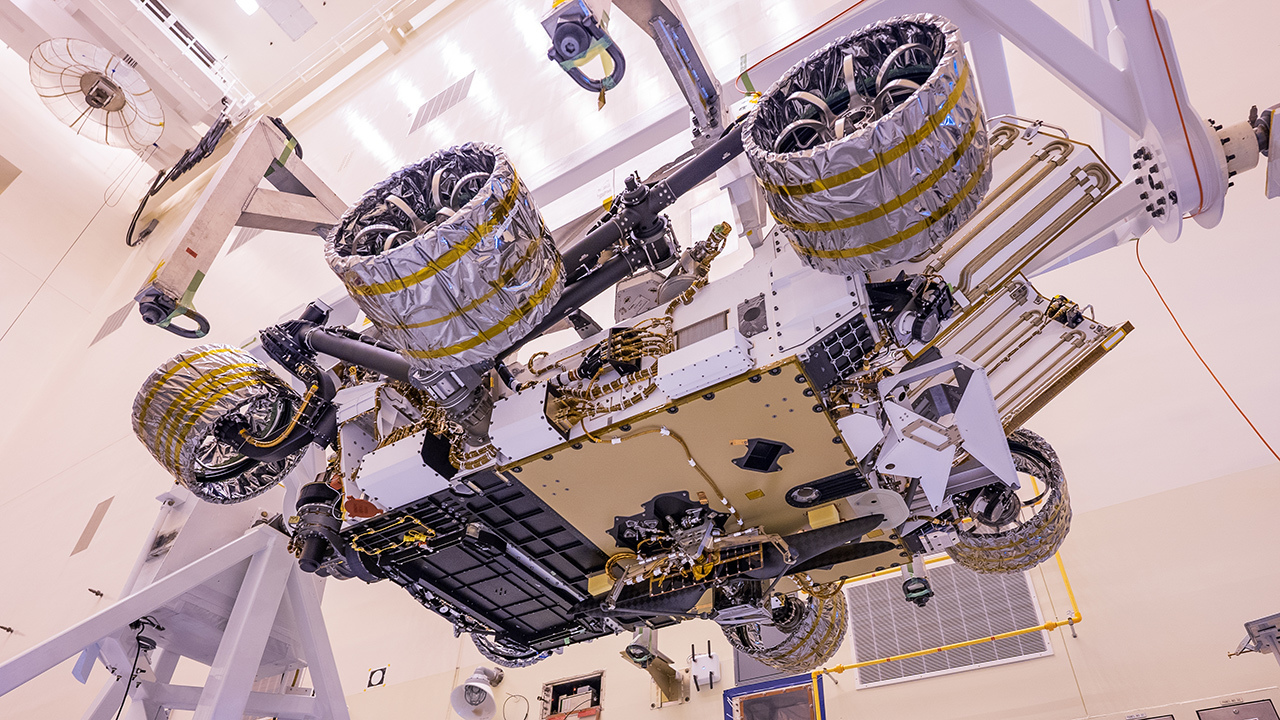
The team also fueled the rover’s sky crane to get ready for this summer’s history-making launch.
With the launch period of NASA’s Mars 2020 Perseverance rover opening in 14 weeks, final preparations of the spacecraft continue at the Kennedy Space Center in Florida. In the past week, the assembly, test and launch operations team completed important milestones, fueling the descent stage — also known as the sky crane — and attaching the Mars Helicopter, which will be the first aircraft in history to attempt power-controlled flight on another planet.
Over the weekend, 884 pounds (401 kilograms) of hydrazine monopropellant were loaded into the descent stage’s four fuel tanks. As the aeroshell containing the descent stage and rover enter the Martian atmosphere on Feb. 18, 2021, the propellant will be pressure-fed through 120 feet (37 meters) of stainless steel and titanium tubing into eight Mars landing engines. The engines‘ job: to slow the spacecraft, which will be traveling at about 180 mph (80 meters per second) when it’s 7,200 feet (2,200 meters) in altitude, to 1.7 mph (0.75 meters per second) by the time it’s about 66 feet (20 meters) above the surface.
Maintaining this rate of descent, the stage will then perform the sky crane maneuver: Nylon cords spool out to lower the rover 25 feet (7.6 meters) below the descent stage; When the spacecraft senses touchdown at Jezero Crater, the connecting cords are severed and the descent stage flies off.
„The last hundred days before any Mars launch is chock-full of significant milestones,“ said David Gruel, the Mars 2020 assembly, test and launch operations manager at JPL. „Fueling the descent stage is a big step. While we will continue to test and evaluate its performance as we move forward with launch preparations, it is now ready to fulfill its mission of placing Perseverance on the surface on Mars.“
The Helicopter
After the descent stage fueling, the system that will deliver the Mars Helicopter to the surface of the Red Planet was integrated with Perseverance. The helicopter, which weighs 4 pounds (1.8 kilograms) and features propellers 4 feet (1.2 meters) in diameter, is cocooned within the delivery system. In one of the first steps in the day-long process on April 6, technicians and engineers made 34 electrical connections between the rover, the helicopter and its delivery system on the rover’s belly. After confirming data and commands could be sent and received, they attached the delivery system to the rover.
Finally, the team confirmed the helicopter could receive an electrical charge from the rover. Before being deployed onto the surface of Jezero Crater, the Mars Helicopter will rely on the rover for power. Afterward, it will generate its own electrical power through a solar panel located above its twin counter-rotating propellers.
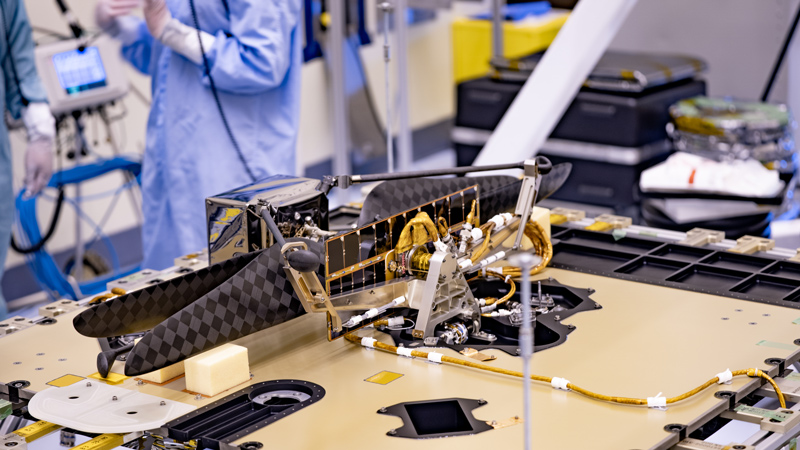
The helicopter will remain encapsulated on the rover’s belly for the next year and will be deployed around the beginning of May — roughly two-and-a-half months after Perseverance’s landing. Once the rover drives about 330 feet (100 meters) away and the helicopter undergoes an extensive systems check, it will execute a flight-test campaign for up to 30 days.
The Perseverance rover is a robotic scientist weighing 2,260 pounds (1,025 kilograms). It will search for signs of past microbial life, characterize the planet’s climate and geology, collect samples for future return to Earth and pave the way for human exploration of the Red Planet. No matter what day Perseverance launches during its July 17-Aug. 5 launch period, it will land on Mars‘ Jezero Crater on Feb. 18, 2021.
The Mars 2020 Perseverance rover mission is part of a larger program that includes missions to the Moon as a way to prepare for human exploration of the Red Planet. Charged with returning astronauts to the Moon by 2024, NASA will establish a sustained human presence on and around the Moon by 2028 through NASA’s Artemis lunar exploration plans.
For more information about the mission, go to:
https://mars.nasa.gov/mars2020/
For more about NASA’s Moon to Mars plans, visit:
https://www.nasa.gov/topics/moon-to-mars
Entry, Descent, and Landing Technologies
Mars 2020 verfügt über eine Reihe von Kameras, mit denen Ingenieure verstehen können, was während eines der riskantesten Teile der Mission geschieht: Einfahrt, Abstieg und Landung. Der Perseverance Rover basiert stark auf dem erfolgreichen Missionsdesign von Curiosity, aber Mars 2020 erweitert das Design des Raumfahrzeugs um mehrere Abstiegskameras.
Die Kamerasuite umfasst: Fallschirm-Up-Look-Kameras, eine Down-Stage-Down-Look-Kamera, eine Rover-Up-Look-Kamera und eine Rover-Down-Look-Kamera. Das Mars 2020 EDL-System enthält auch ein Mikrofon zur Erfassung von Geräuschen während der EDL, z. B. das Abfeuern von Abstiegsmotoren. Niemand hat jemals eine Fallschirmöffnung in der Marsatmosphäre gesehen, bei der der Rover an die Oberfläche gesenkt wurde…..
The Mars 2020 rover mission has major new technologies that improve entry, descent, and landing: Range Trigger, Terrain-Relative Navigation, MEDLI2, and its EDL cameras and microphone.
Range Trigger

The Range Trigger technique shrinks the Mars 2020 rovers landing ellipse significantly, landing the rover closer to the target area of scientific interest. This example shows Mars 2020’s ellipse in relationship to Mars rover Curiosity’s landing ellipse. Mars 2020 will be landing in a different location. Credit: NASA/JPL-Caltech.
Download full image ›
A Major Improvement in Landing Accuracy
It’s hard to land on Mars, and even harder to land a rover close to its prime scientific target. Previous rovers have landed in the general vicinity of areas targeted for study, but precious weeks and months can be used up just traveling to a prime target. The Mars 2020 mission team is working on a strategy to put the rover on the ground closer to its prime target than was ever before possible. The Range Trigger technology reduces the size of the landing ellipse (an oval-shaped landing area target) by more than 50%. The smaller ellipse size allows the mission team to land at some sites where a larger ellipse would be too risky given they would include more hazards on the surface. That gives scientists access to more high priority sites with environments that could have supported past microbial life.
Range Trigger – It’s All About Timing
The key to the new precision landing technique is choosing the right moment to pull the „trigger“ that releases the spacecraft’s parachute. „Range Trigger“ is the name of the technique that Mars 2020 uses to time the parachute’s deployment. Earlier missions deployed their parachutes as early as possible after the spacecraft reached a desired velocity. Instead of deploying as early as possible, Mars 2020’s Range Trigger deploys the parachute based on the spacecraft’s position relative to the desired landing target. That means the parachute could be deployed early or later depending on how close it is to its desired target. If the spacecraft were going to overshoot the landing target, the parachute would be deployed earlier. If it were going to fall short of the target, the parachute would be deployed later, after the spacecraft flew a little closer to its target.
Shaving Time Off the Commute
The Range Trigger strategy could deliver the Mars 2020 Perseverance rover a few miles closer to the exact spot in the landing area that scientists most want to study. It could shave off as much as a year from the rover’s commute to its prime work site.Another potential advantage of testing the Range Trigger is that it would reduce the risk of any future Mars Sample Return mission, because it would help that mission land closer to samples cached on the surface.
Terrain-Relative Navigation
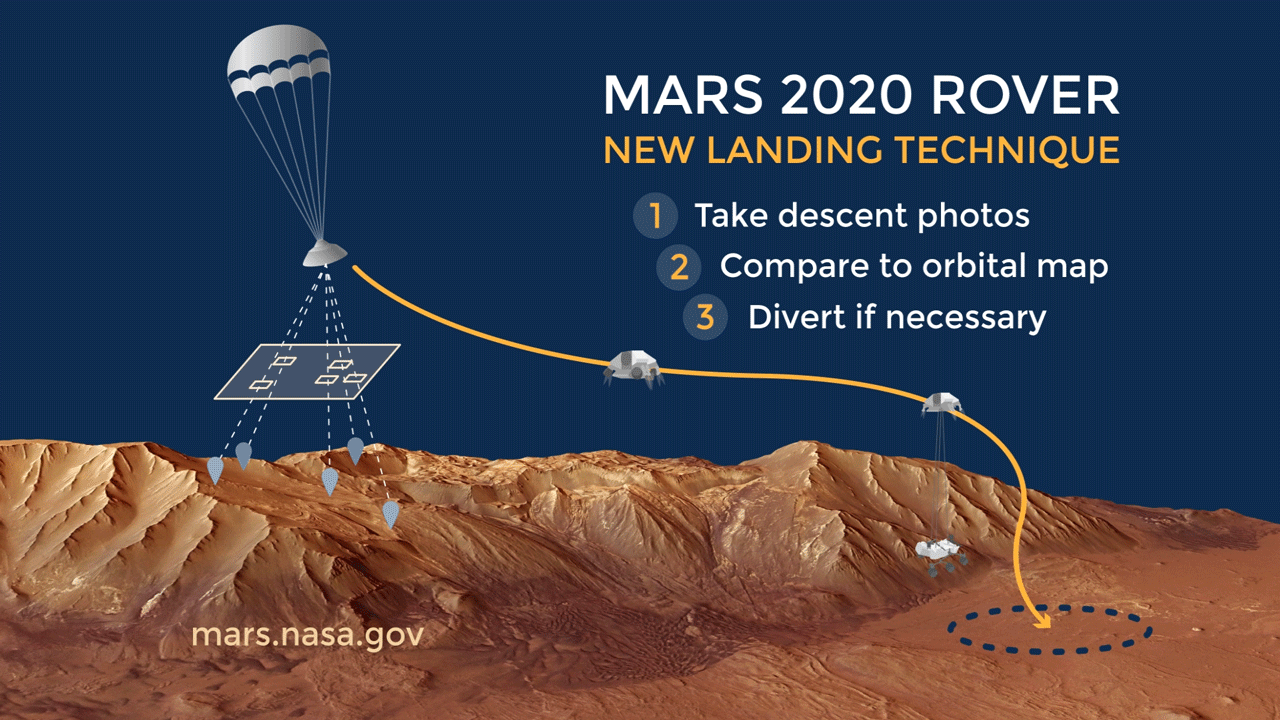
Terrain-Relative Navigation is an innovative entry, descent, and landing technology that allows the rover to detect tricky terrain and divert itself to a safer landing area. Credit: NASA/JPL-Caltech.
Download full image ›
Terrain-Relative Navigation helps us land safely on Mars – especially when the land below is full of hazards like steep slopes and large rocks!
How Terrain-Relative Navigation Works
- Orbiters create a map of the landing site, including known hazards.
- The rover stores this map in its computer „brain.“
- Descending on its parachute, the rover takes pictures of the fast approaching surface.
- To figure out where it’s headed, the rover quickly compares the landmarks it „sees“ in the images to its onboard map.
- If it’s heading toward dangerous ground up to about 985 feet (300 meters) in diameter (about the size of two professional baseball fields side by side), the rover can change direction and divert itself toward safer ground.
Why Terrain-Relative Navigation is Important
Terrain-Relative Navigation is critical for Mars exploration. Some of the most interesting places to explore lie in tricky terrain. These places have special rocks and soils that might preserve signs of past microbial life on Mars!
Until now, many of these potential landing sites have been off-limits. The risks of landing in challenging terrain were much too great. For past Mars missions, 99% of the potential landing area (the landing ellipse) had to be free of hazardous slopes and rocks to help ensure a safe landing. Using terrain relative navigation, the Mars 2020 rover can land in more – and more interesting! – landing sites with far less risk.
How Terrain-Relative Navigation Improves Entry, Descent, & Landing
Terrain-Relative Navigation significantly improves estimates of the rover’s position relative to the ground. Improvements in accuracy have a lot to do with when the estimates are made.
In prior missions, the spacecraft carrying the rover estimated its location relative to the ground before entering the Martian atmosphere, as well as during entry, based on an initial guess from radiometric data provided through the Deep Space Network. That technique had an estimation error prior to EDL of about 0.6 – 1.2 miles (about 1-2 kilometers), which grows to about (2 – 3 kilometers) during entry.
Using Terrain-Relative Navigation, the Perseverance rover will estimate its location while descending through the Martian atmosphere on its parachute. That allows the rover to determine its position relative to the ground with an accuracy of about 200 feet (60 meters) or less.It takes two things to reduce the risks of entry, descent, and landing: accurately knowing where the rover is headed and an ability to divert to a safer place when headed toward tricky terrain.
MEDLI2
Improving Models of the Martian Atmosphere for Robotic and Future Human Missions to Mars.
MEDLI2 is a next-generation sensor suite for entry, descent, and landing (EDL). MEDLI2 collects temperature and pressure measurements on the heat shield and afterbody during EDL.
MEDLI2 is based on an instrument flown on NASA’s Mars Science Laboratory (MSL) mission. MEDLI stands for „MSL Entry, Descent, and Landing Instrumentation.“ The original only collected data from the heat shield. MEDLI2 can collect data from the heat shield and from the afterbody as well.This data helps engineers validate their models for designing future entry, descent, and landing systems. Entry, descent, and landing is one of the most challenging times in any landed Mars mission. Atmospheric data from MEDLI2 and MEDA, the rover’s surface weather station, can help scientists and engineers understand atmospheric density and winds. The studies are critical for reducing risks to both robotic and future human missions to Mars.
Entry, Descent, and Landing (EDL) Cameras and Microphone
Unprecedented Visibility into Mars Landings
Mars 2020 has a suite of cameras that can help engineers understand what is happening during one of the riskiest parts of the mission: entry, descent, and landing. The Perseverance rover is based heavily on Curiosity’s successful mission design, but Mars 2020 adds multiple descent cameras to the spacecraft design.
The camera suite includes: parachute „up look“ cameras, a descent-stage „down look“ camera, a rover „up look“ camera, and a rover „down look“ camera. The Mars 2020 EDL system also includes a microphone to capture sounds during EDL, such as the firing of descent engines.
A First-Person View of Landing on Mars
In addition to providing engineering data, the cameras and microphone can be considered „public engagement payloads.“ They are likely to give people on Earth a good and dramatic sense of the ride down to the surface! Memorable videos depicting EDL’s „Seven Minutes of Terror for the 2012 landing of NASA’s Curiosity Mars rover went viral online, but used computer-generated animations. No one has ever seen a parachute opening in the Martian atmosphere, the rover being lowered down to the surface of Mars on a tether from its descent stage, the bridle between the two being cut, and the descent stage flying away after rover touchdown!
10.9 Million Names Now Aboard NASA’s Perseverance Mars Rover
Auch die Namen: von mir und allen anderen auf der Welt wurden bereits installiert
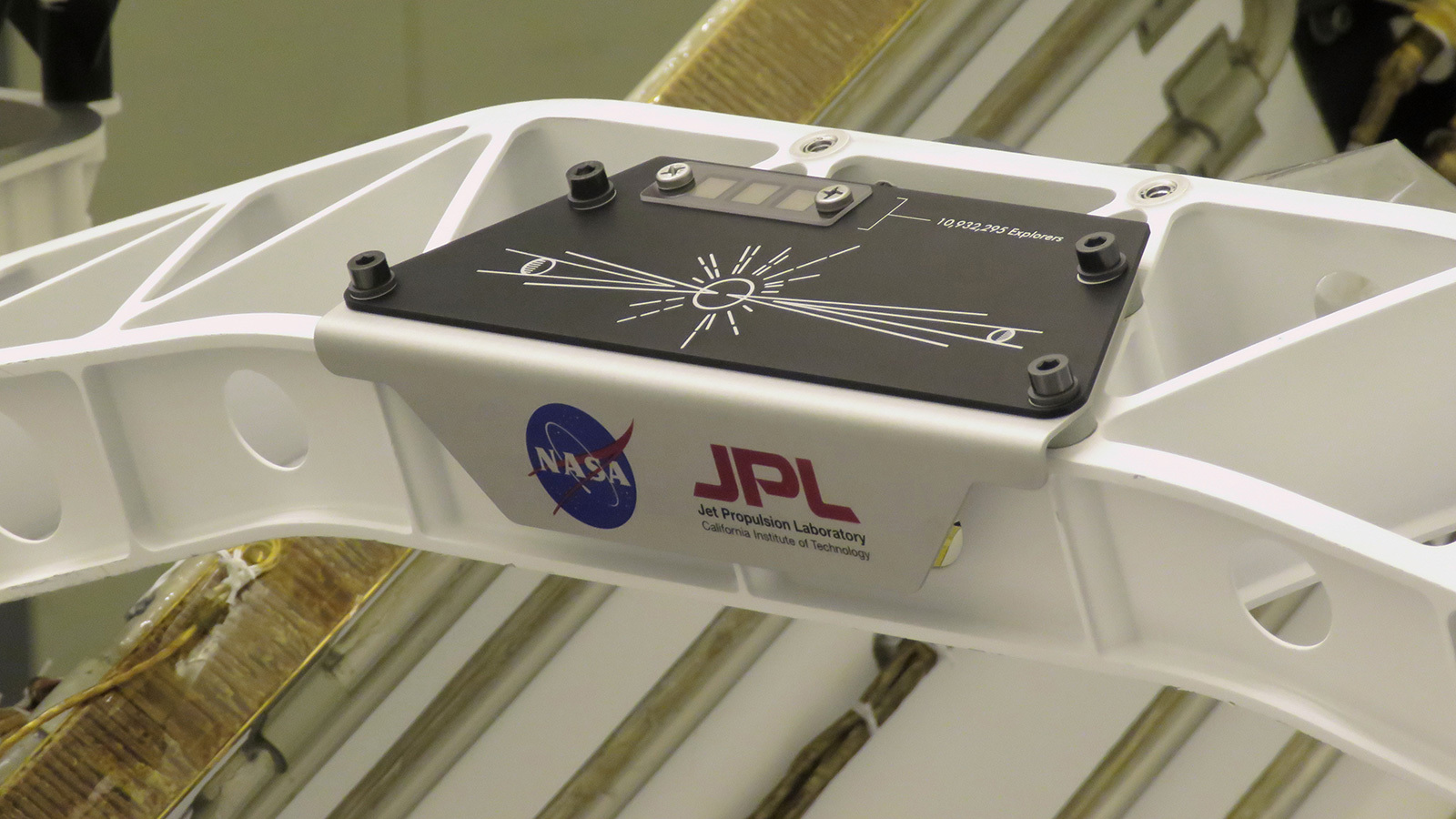
As part of NASA’s ‚Send Your Name to Mars‘ campaign, they’ve been stenciled onto three microchips along with essays from NASA’s ‚Name the Rover‘ contest. Next stop: Mars.
NASA’s „Send Your Name to Mars“ campaign invited people around the world to submit their names to ride aboard the agency’s next rover to the Red Planet. Some 10,932,295 people did just that. The names were stenciled by electron beam onto three fingernail-sized silicon chips, along with the essays of the 155 finalists in NASA’s „Name the Rover“ contest. The chips were then were attached to an aluminum plate on NASA’s Perseverance Mars rover at Kennedy Space Center in Florida on March 16. Scheduled to launch this summer, Perseverance will land at Jezero Crater on Feb. 18, 2021.
The three chips share space on the anodized plate with a laser-etched graphic depicting Earth and Mars joined by the star that gives light to both. While commemorating the rover that connects the two worlds, the simple illustration also pays tribute to the elegant line art of the plaques aboard the Pioneer spacecraft and golden records carried by Voyagers 1 and 2. Affixed to the center of the rover’s aft crossbeam, the plate will be visible to cameras on Perseverance’s mast.
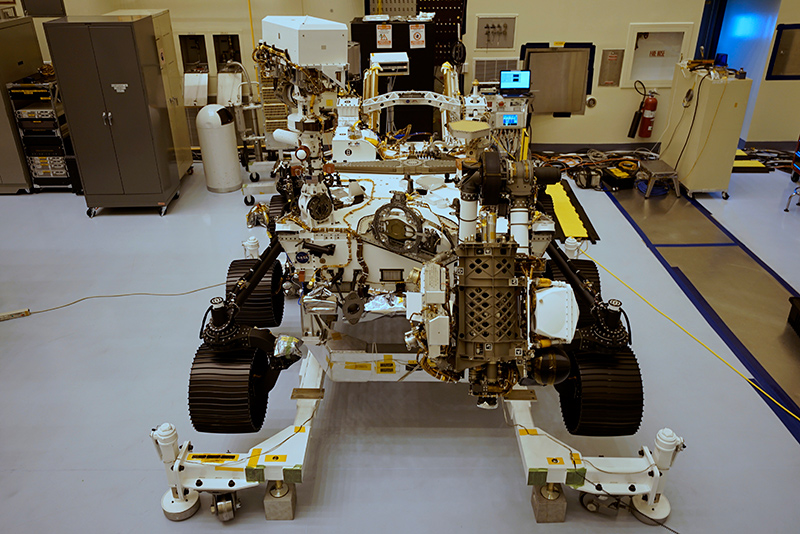
Currently, the coronavirus has not impacted the Mars Perseverance rover launch schedule. The installation was one of numerous recent activities performed by the Perseverance assembly, test and launch operations team. On March 21, the team began reconfiguring the rover so it can ride atop the Atlas V rocket. Steps included stowing the robotic arm, lowering and locking in place the remote sensing mast and high-gain antenna, and retracting its legs and wheels.
The Perseverance rover is a robotic scientist weighing just under 2,300 pounds (1,043 kilograms). It will search for signs of past microbial life, characterize Mars‘ climate and geology, collect samples for future return to Earth, and help pave the way for human exploration of the Red Planet.